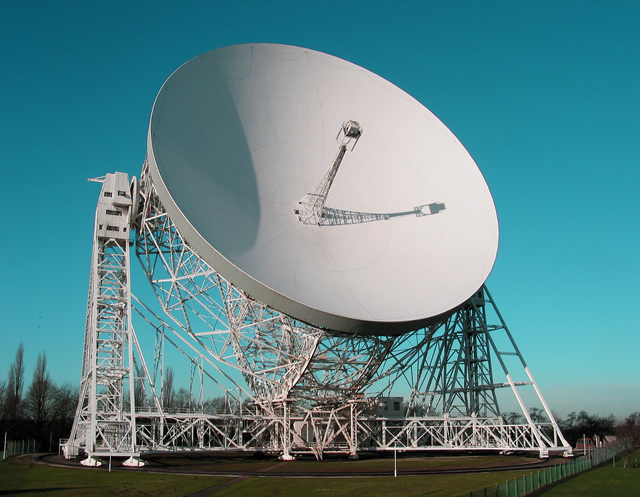
The Lovell Telescope at Jodrell Bank – Credit: Anthony Holloway, University of Manchester
Un nuovo network è stato lanciato per promuovere la ricerca accademica nel Regno Unito relativa al SETI (Search for ExtraTerrestrial Intelligence – Ricerca di Intelligenza Extraterrestre) . Il UK SETI Research Network (UKSRN) riunisce accademici provenienti da 11 istituzioni in tutto il paese. Patrono del network è l’Astronomo Reale, il professor Martin Rees. UKSRN ha presentato l’attività in corso e le considerazioni sulla strategia futura in una sessione con tavola rotonda al Meeting Nazionale di Astronomia a St Andrews, venerdì 5 luglio.
UKSRN (www.seti.ac.uk) copre un ampio spettro di temi di ricerca, tra i quali i potenziali metodi per la rilevazione dei segnali, la sfida linguistica su eventuali messaggi da decifrare, la probabilità che una civiltà extraterrestre possa interagire con la Terra e la longevità della stessa civiltà. Il dott. Alan Penny, coordinatore del UKSRN ha detto: “Ci auguriamo che l’esistenza della rete ecciterà l’interesse in persone della comunità astronomica del Regno Unito che stanno pensando al SETI e incoraggiarle a contribuire al progetto di ricerca con il loro lavoro. In questa sessione del National Astronomy Meeting (NAM), abbiamo presentato alla Comunità l’intera gamma delle attività del SETI nel Regno Unito con la speranza che possa favorire una più ampia comprensione della ricerca, su questo argomento.” Il dr. Tim O’Brien dell’Università di Jodrell Bank, Osservatorio di Manchester, ha descritto la capacità di uno dei sette più recenti radio-telescopi gamma e-MERLIN commissionato appositamente per il progetto SETI ed ha riferito sui progressi dei test nelle osservazioni iniziate nel Regno Unito. La prima proposta per la ricerca di segnali radio provenienti da civiltà extraterrestri è stato effettivamente ispirato dalla costruzione del telescopio Lovell a Jodrell Bank “, ha detto O’Brien.” Siamo andati a prendere parte al Progetto Phoenix del SETI Institute relativo agli anni 1998-2003, alla ricerca di segnali provenienti da circa un migliaio di stelle vicine. A quel tempo le attrezzature necessarie per vagliare i dati erano costose e rare, ma ora i nostri moderni telescopi sono potenzialmente in grado di condurre questo tipo di osservazioni come una cosa naturale. “L’array e-MERLIN, che comprende il telescopio Lovell, è collegato da fibre ottiche e si sviluppa su 217 km da Jodrell Bank a Cambridge. L’approccio multi-telescopio offre un potenziale per distinguere i veri segnali extraterrestri dalle interferenze generate qui sulla Terra, un problema chiave per tutti i progetti radio del SETI.
A network has been launched to promote academic research in the UK relating to the Search for ExtraTerrestrial Intelligence (SETI). The UK SETI Research Network (UKSRN) brings together academics from 11 institutions across the country. The network’s Patron is the Astronomer Royal, Professor Martin Rees.
UKSRN will present current activity and consider future strategy in a session and panel discussion at the National Astronomy Meeting in St Andrews on Friday 5 July. UKSRN (www.seti.ac.uk) covers a broad spectrum of research topics, including potential methods for detecting signals, the linguistic challenge of deciphering messages, the probability of an extraterrestrial civilization interacting with Earth and the longevity of civilizations. Dr Alan Penny, the coordinator of UKSRN said, “We hope that the existence of the network will excite interest from people in the UK astronomical community that have been thinking about SETI and encourage them to contribute their work. In this session at NAM, we are presenting the whole range of UK SETI activities to the community and hope that it will promote a wider understanding of, and activity in, this subject.” Dr Tim O’Brien from The University of Manchester’s Jodrell Bank Observatory will describe the capability of the UK’s recently commissioned e-MERLIN array of seven radio telescopes for SETI projects and report on progress in initial test observations. The first proposal to search for radio signals from extraterrestrial civilisations was actually inspired by the construction of the Lovell Telescope at Jodrell Bank,” said O’Brien. “We went on to take part in the SETI Institute’s Project Phoenix from 1998 to 2003, searching for signals from about a thousand nearby stars. At that time the equipment required to sift through the data was expensive and unusual, but our modern telescopes are potentially capable of conducting these type of observations as a matter of course.” The e-MERLIN array, which includes the Lovell Telescope, is connected by optical fibres and spread over 217 km from Jodrell Bank to Cambridge. This multi-telescope approach offers potential for distinguishing true extraterrestrial signals from interference generated here on Earth, a key problem for all radio SETI projects.
Source/Continue reading → Royal Astronomic Society





















